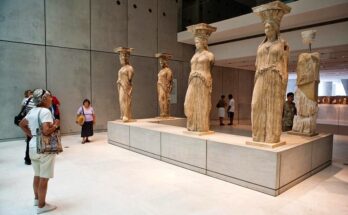
The ancient Amphipolis tomb, one of the most significant archaeological discoveries of the 21st century, is due to open to visitors in 2027.
Experts and Greek antiquity enthusiasts are eagerly awaiting the opening of the tomb in Eastern Macedonia, Greece. When it was unearthed in 2014, it captivated the entire nation.
Since then, significant efforts have been taking place to restore the site and make it accessible to visitors from all over the world.
Culture Minister Lina Mendoni visited the site this week to inspect the restoration works.
“The Kasta Tomb, in Amphipolis, is a unique monument in Greece, with international prominence,” she said. “Important milestones for the restoration of the monument are now complete. The dome above the statues of the two sphinxes has already been restored.”

“What we seek is for the monument, precisely because of its uniqueness, to be – as much as possible – accessible to disabled visitors,” Mendoni added.
The Greek Culture Ministry released photos of the restored mosaics that adorn the monument.
The abduction of Persephone by Hades, the king of the Underworld according to Greek mythology, is a stunning mosaic that was unearthed at Amphipolis a few years ago, fascinating Greece.

The female figure is shown with fiery red hair, and archaeologists have expressed their certainty that the mosaic depicts the abduction of Persephone by Hades. That makes the bearded man crowned with the laurel Hades and not the person buried in the tomb, as many originally believed.
The third figure is Hermes, who guides the chariot to the Underworld. The abduction of Persephone by Hades is a common theme in artwork of the Hellenistic period. A similar depiction appears in a mural in the Aiges royal tomb.
The culture ministry described the mosaic as stunning, superbly rich in color and artistic detail, that aspects of it appear three dimensional, the figure of Hermes in particular.

Who is buried in the Amphipolis Tomb?
The question of who is buried there remains a mystery.
The Amphipolis Tomb is the largest burial mound ever discovered in Greece and by comparison dwarfs that of Philip II of Macedon, father of Alexander the Great, in Vergina.
The site is believed to date back to the late 4th century BC, during the reign of Alexander the Great or shortly after his death.
It displays remarkable craftsmanship and intricate architectural features that indicate an individual of great importance. The tomb’s strategic location near Amphipolis, a significant ancient city, also suggests its connection to prominent figures of the time.
In early 2015, the Ministry announced the discovery of the remains of five individuals in the third chamber, the main burial chamber, sparking excitement in the media and intense scholarly debate among archaeologists and historians.
Only the elderly woman’s skeleton had a skull. Close investigation of the younger man’s bones revealed unhealed wounds, deep cut marks, suggesting he had met a violent death.
Despite extensive forensic analysis, the exact identity of the tomb’s five occupants remains a mystery.
Potential candidates
Initial public speculation that, due to its size and cost of construction, it could be the tomb of Alexander the Great, was dismissed by experts when commenting on the published findings, as the available historical records mention Alexandria in Egypt as the final resting place of Alexander’s body.
Another hypothesis concerning the occupant of the Amphipolis Tomb is that it may belong to Hephaestion, a close companion of Alexander the Great.
The case for Olympias, Alexander’s mother, as the primary occupant of the Amphipolis Tomb is popular among scholars, largely due to the remains of a woman who died at approximately the same age as Olympias being the likely occupant of the cist grave in the main burial chamber.
The iconography of the decoration in the tomb also strongly suggests a high-status female occupant, sphinxes being symbols of the queen of Macedon, as well as a pair of caryatids (maidens) at the entrance of the second chamber.
Another compelling theory points to Roxana, Alexander the Great’s wife. Roxana, a Persian princess, held great influence and played a crucial role in Alexander’s political dealings. Her interment in a tomb of this caliber would be in accordance with her elevated position and significance in Alexander’s life.
Yet another possibility is that the Amphipolis Tomb may belong to a prominent member of the Macedonian royal family. With its lavish decorations and astronomical cost, the tomb could have been designed to honor one of the ruling dynasties of the time, such as the Argeads or the Antigonids.



